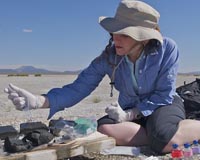 |
Washington (AFP) Dec 2, 2010 Bacteria that thrive on arsenic have been scooped from a California lake, a discovery that redefines the building blocks of life and offers new hope in the search for other organisms on Earth and beyond. Not only do the bacteria survive, they grow by swapping phosphorus for arsenic in their DNA and cell membranes, said the study funded by the US space agency NASA and published Thursday in the journal Science. The findings add a new dimension to what biologists consider the necessary elements for life, currently viewed as six elements: carbon, hydrogen, nitrogen, oxygen, phosphorus and sulfur. "What we've found is a microbe doing something new -- building parts of itself out of arsenic," said scientist Felisa Wolfe-Simon, a fellow in NASA's astrobiology program who made the groundbreaking discovery at Mono Lake in eastern California. "There's an organism on Earth doing something different," said Wolfe-Simon. "We've cracked open the door to what's possible for life elsewhere in the universe. And that's profound." Ariel Anbar, a co-author of the study, explained how Wolfe-Simon was able to get the bacteria known as strain GFAJ-1 of the Halomonadaceae family of Gamoproteobacteria to grow under extreme arsenic-laden conditions in the lab. "She takes this sediment, puts it in a bottle essentially where there is lots of arsenic and very little phosphorus, and she does it over and over so only organisms that are going to be happy in that environment survive," said Anbar. "The organism came from nature," said Anbar, a scientist at Arizona State University's School of Earth and Space Exploration. "It is a known bacteria. It is not a brand new bug but nobody realized it could do this," he said. Scientists have known for some time that some microbes can use arsenic for energy, much like humans do with oxygen or food. "The way I like to put it is they smoke it but they don't inhale it," said Paul Davies, a co-author of the paper and British-born cosmologist at Arizona State University. "So the big question we all wanted to know was where has the arsenic gone? Is the arsenic really in their innards? "Eventually, bit by bit, the evidence accumulated that indeed the arsenic was in the DNA, the proteins, the lipid membranes and the metabolites, so it was everywhere where it is important." The trio of Wolfe-Simon, Anbar and Davies published in 2009 their hypothesis that arsenic, which is directly below phosphorus on the periodic table, could substitute for phosphorus in Earth life forms. "We conjectured that maybe life started via the arsenic route and phosphorus was the later adaptation," said Davies, noting that they still are not sure which came first, or if this bacteria could be "like a living fossil, a hangover from an earlier arsenic epoch." But the discovery has made him think about all the forms of life out there that scientists may have missed. "This is going to open up a whole new line of inquiry. First of all this can't be the only arsenic organism on the planet, there is going to a be lot more, so this is a whole new domain of microbiology that it represents," said Davies. "Who knows what else is out there if we take a harder look?" The findings, leaked early in a vague but intriguing announcement by NASA that mentioned "extraterrestrial life," lit up the blogosphere and stunned many scientists. Arizona State University professor James Elser said he has spent years telling students that phosphorus was a necessary part of DNA. "The idea that I am sitting here today discussing the idea that this is not true is shocking," said Elser, a panelist at a NASA press conference on the discovery. Caleb Scharf, a Columbia University astrobiologist, told The New York Times he was amazed. "It's like if you or I morphed into fully functioning cyborgs after being thrown into a room of electronic scrap with nothing to eat," he said. NASA has conducted numerous probes at eastern California's Mono Lake, an unusually salty body of water with high arsenic and mineral levels, as it is likely to reflect conditions under which early life evolved on Earth, or perhaps Mars. "Sometimes you think something is not going to work, but then you go looking for it and sometimes you may find it," said Anbar. "And then you realize, oh, I didn't understand things quite as well as I thought I did before. And that happens all the time in science. That's part of what makes it fun."
Share This Article With Planet Earth
Related Links Life Beyond Earth Lands Beyond Beyond - extra solar planets - news and science
 Arsenic-Eating Bacteria Points To New Types Of Life
Arsenic-Eating Bacteria Points To New Types Of LifeMoffett Field CA (SPX) Dec 2, 2010 One of the basic assumptions about life on Earth may be due for a revision. Scientists have discovered a type of bacteria that thrives on poisonous arsenic, potentially opening up a new pathway for life on Earth and other planets. If you thumb through an introductory biology textbook, you'll notice that six elements dominate the chemistry of life. Carbon, hydrogen, oxygen and nitrogen are ... read more |
|
| The content herein, unless otherwise known to be public domain, are Copyright 1995-2010 - SpaceDaily. AFP and UPI Wire Stories are copyright Agence France-Presse and United Press International. ESA Portal Reports are copyright European Space Agency. All NASA sourced material is public domain. Additional copyrights may apply in whole or part to other bona fide parties. Advertising does not imply endorsement,agreement or approval of any opinions, statements or information provided by SpaceDaily on any Web page published or hosted by SpaceDaily. Privacy Statement |